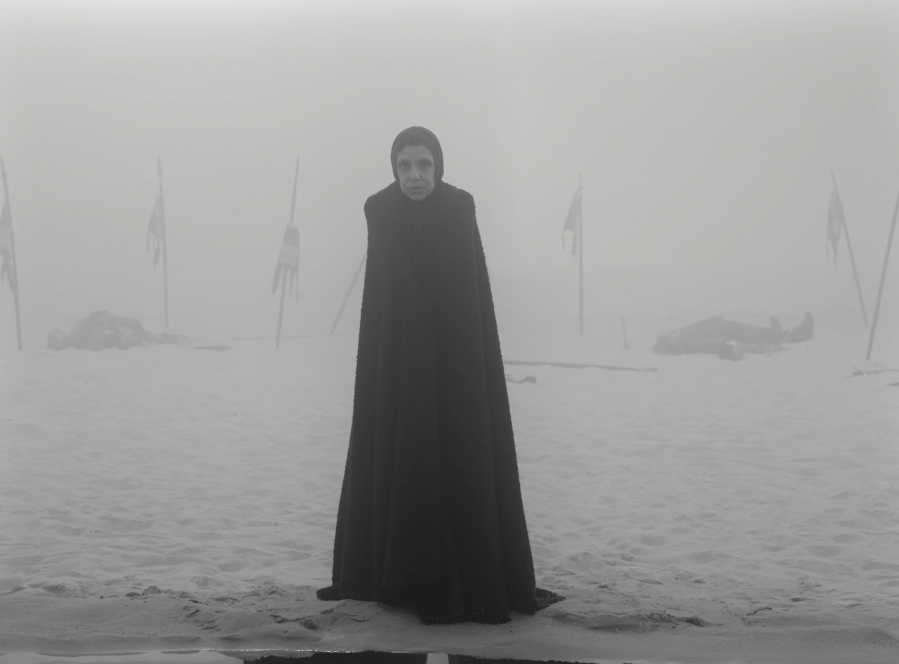My sister’s high school film students rebel when she tries to show black-and-white movies. But they’d better get used to it because multiplexes are about to be invaded by monochromatic films.
Four end-of-the-year awards contenders are ROYGBIV-less: Kenneth Branagh’s “Belfast,” “C’mon C’mon” with Joaquin Phoenix, “Passing” on Netflix and Joel Coen’s “The Tragedy of Macbeth,” which opens Dec. 25. That could be more noncolor films than we’ve had at any one time since their premature “death” in 1966, the last year an Oscar was given for black-and-white cinematography (“Who’s Afraid of Virginia Woolf” won). We probably should have known when 2021 got off to a start with John David Washington and Zendaya in “Malcolm & Marie.”
There are plenty of reasons to shoot a movie in black and white but often it’s to anchor it in the past. Our great-grandmothers — and everything else — were in color, of course, but monochromatic images seem to take us back, perhaps because we’re aware that black-and-white photographs preceded color ones. Draining the frame of color immediately transports us out of the present and into whatever tale the filmmakers have dreamed up.
“Belfast” takes clever liberties with that. Cinematographer Haris Zambarloukos opens it with color images of the city today before shifting to 1969 and going black and white. But, at key moments in the movie, color is reintroduced. When the central family goes to the movies, they stay in black and white but “Chitty Chitty Bang Bang” is in vivid color, maybe to hint there’s a life for them far from the Troubles that rage outside their front door. When the film’s Buddy (Jude Hill) and his grandmother (Judi Dench) attend a production of “A Christmas Carol,” it’s also in color.
Obviously, Branagh is not the first contemporary director to fall in love with black-and-white images. Joel and Ethan Coen (“The Man Who Wasn’t There”), Steven Spielberg (“Schindler’s List”), Alfonso Cuaron (“Roma”) and David Fincher (“Mank”) are right there with him. Those films were all nominated for cinematography Oscars and it would not be surprising to see a couple of this year’s films join that club. Two fairly recent best picture winners, “Schindler” and “The Artist,” demonstrate that Oscar voters like black and white almost as much as folks such as Steven Soderbergh, whose “Kafka” is colorless.
Still, my sister’s students are not the only ones who want color. Black-and-white films rarely become hits. That’s why filmmakers must fight for it passionately, and maybe why the few movies that do get made that way tend to be good, or at least good looking.
Both are true of my favorite latter-day black-and-white movies, which don’t need color to make an impact.
‘The Man Who Wasn’t There’
The Coens’ melodrama was shot by frequent collaborator Roger Deakins, who earned one of his 15 Oscar nominations because he does such inventive things with the camera. He nods to the film noir movies that inspired “Man” with, for instance, a shot in which bars of light trap Billy Bob Thornton as he’s about to head to the slammer.
‘Raging Bull’
A paradox: Black-and-white movies feel gritty and realistic, even though reality is not black and white. The events depicted in Martin Scorsese’s boxing-themed drama occurred, but cinematographer Michael Chapman achieves a dreamlike, surreal quality with weird flashes of light as well as speeded-up and slowed-down images. Chapman said the idea was to reflect the reality of title character Jake LaMotta, who’s split between cool confidence in the ring and chaos outside of it.
‘Frances Ha’
Black and white is usually reserved for dramas but Noah Baumbach’s comedy is a bracing exception, in which he and cinematographer Sam Levy chose a blurry, deliberately low-fi look to salute the French New Wave movies, such as “Jules and Jim,” that inspired them.
‘She’s Gotta Have It’
Spike Lee may have shot in black and white because it’s stylishly melancholy but it also underlines a key theme, which is that white people make it difficult for Nola Darling, who is Black and dating around, to find professional or personal happiness.
‘Dead Men Don’t Wear Plaid’
The Steve Martin comedy is droll but its real achievement is its technical wizardry. The script works Martin’s gumshoe character into existing film noir movies, then cinematographer Chapman matched contemporary footage of Martin and others with existing scenes featuring Humphrey Bogart and Joan Crawford. It sounds like it wouldn’t work but it does, and it demonstrates how many different variations of black and white are possible.



